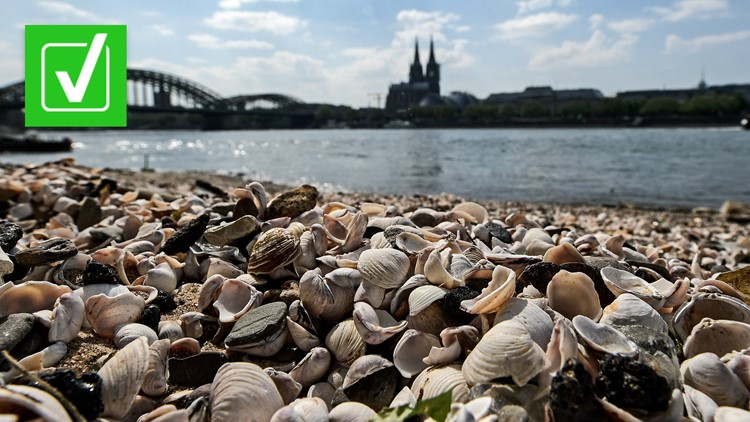Heat is the leading weather-related killer in the United States. In the Pacific Northwest, a late June heat wave, caused by a weather phenomenon called a heat dome, in which the atmosphere traps hot ocean air, led to the deaths of hundreds of people. Temperatures over 115 degrees were reported in Washington and Oregon. A new record-high temperature in Canada was reached in Lytton, a small town in British Columbia, which got up to 121 degrees. The town was soon after destroyed by a wildfire.
But it’s not just humans who are affected by extreme heat. In the days after the Pacific Northwest heat dome, people attributed the extreme weather event to the deaths of marine animals. That included U.S. Senator Bernie Sanders. Others said the heat dome led to the deaths of 1 billion sea creatures.
THE QUESTION
Is extreme heat killing sea life?
THE SOURCES
- Christopher Harley, professor with the Department of Zoology at the University of British Columbia
- Ken Fong, head of stock assessment and research division at Fisheries and Oceans Canada
- World Weather Attribution
- World Meteorological Organization
- United Nations’ Intergovernmental Panel on Climate Change
- National Oceanic and Atmosphere Administration (NOAA)
- NOAA Fisheries
- Study published in Public Library of Science
THE ANSWER
Yes, experts have attributed the deaths of sea life to extreme heat events influenced by climate change.
WHAT WE FOUND
Christopher Harley, a professor with the Department of Zoology at the University of British Columbia, said based on his past work, he knew a heat wave like the one that recently hit British Columbia could create dangerous conditions for living things. So, he walked down to the Vancouver, B.C., coast to assess what impact the heat dome had on sea creatures.
“I could smell it before I even got there,” Harley said of the mass deaths.
Once he got to the shore, Harley’s eyes confirmed what his other senses were telling him.
“The number of dead animals and mussels stretched on and on,” he said.
In addition to mussels, Harley said clams, oysters and sea stars were among the dead sea creatures. He initially estimated more than 1 billion sea creatures died as a result of the heat wave. As he’s further investigated the impact of the heat dome, Harley believes his initial death count estimate was low.
“The numbers almost lose meaning when they’re this big,” he said.
Ken Fong with Canada’s department of fisheries and oceans told VERIFY the agency is aware the heat wave may have killed a large number of seashore animals, but that it was too soon to estimate how many died.
More than 20 scientists with World Weather Attribution, a collaboration of climate scientists throughout the world, concluded the extreme heat wave “was virtually impossible without human-caused climate change.”
“The observed temperatures were so extreme that they lie far outside the range of historically observed temperatures,” the report from World Weather Attribution says. “This makes it hard to quantify with confidence how rare the event was. In the most realistic statistical analysis, the event is estimated to be about a 1 in 1,000-year event in today’s climate.”
In a statement on the World Meteorological Organization’s website, a climate scientist with the United Kingdom’s national weather service said: “Without human-induced climate change, it would have been almost impossible to hit such record-breaking mean June temperatures in the Western United States as the chances of natural occurrence is once every tens of thousands of years…Human influence is estimated to have increased the likelihood of a new record several thousand times.”
In its 2020 state of global climate report, the World Meteorological Organization determined the global mean temperature was 1.2 degrees Celsius above pre-industrial levels.
The United Nations’ Intergovernmental Panel on Climate Change (IPCC) also attributes human activity to warming oceans.
“The ocean has taken up between 20 to 30% of human-induced carbon dioxide emissions since the 1980s, causing ocean acidification,” the IPCC said in a 2019 report. “To date, the ocean has taken up more than 90% of the excess heat in the climate system.”
Data from the National Oceanic and Atmospheric Administration (NOAA) shows the ocean surface temperature has risen for decades. That warming is having an impact on sea life, according to the IPCC.
“Ocean warming and acidification, loss of oxygen and changes in nutrient supplies, are already affecting the distribution and abundance of marine life in coastal areas, in the open ocean and at the sea floor,” the IPCC report says.
The report also notes marine heat waves have doubled in frequency since 1982 and are becoming more intense.
A massive marine heat wave known as “The Blob” engulfed the Pacific Ocean along the West Coast from 2013-2017. NOAA Fisheries says “The Blob” raised sea surface temperatures by as much as 7 degrees Fahrenheit above average. That warming had consequences for sea life.
“In 2015 a record outbreak of toxic algae shut down West Coast Dungeness crab fisheries worth millions of dollars,” NOAA Fisheries said. “Then came seabird die-offs, record numbers of whales entangled in fishing lines, crashing salmon returns, and starving California sea lion pups washing up on beaches, just for starters.”
A study published in the Public Library of Science estimates about 1 million common murres, a seabird of the North Pacific, died of starvation between the summer of 2015 and spring 2016. Researchers linked the seabird die-off to “The Blob.”
Fong said Canada’s department of fisheries and oceans has observed marine heat waves more frequently since 2014.
Harley said past heat waves he’s observed were not as impactful on sea life as the recent heat dome that cooked the U.S. Pacific Northwest and British Columbia.
“Those were not nearly as extensive and not nearly as many species were affected,” he said.
More from VERIFY: Yes, heat is historically the top weather-related killer in the US



